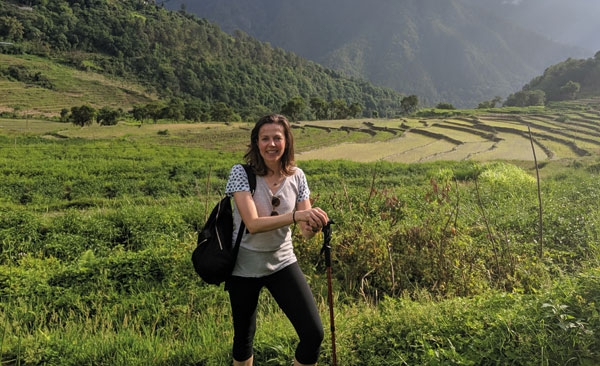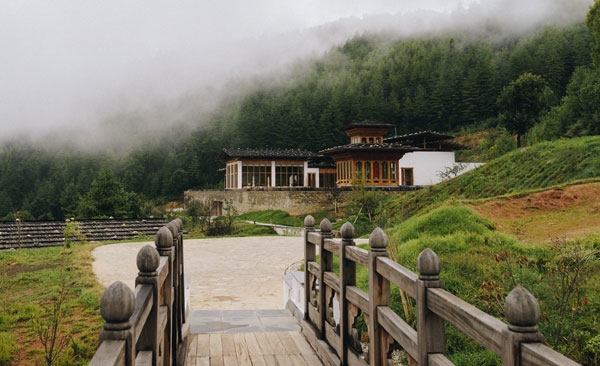Bhutan: Discover the nation which puts happiness above anything else
I’ve never been one for meditation. Sitting still with my eyes closed and emptying my mind when there are so many things to do – children to dress, meetings to attend, articles to write and emails to send – and life to live. In the precious few moments that I do get to relax, I’d rather read a book or tune in to the latest Netflix blockbuster than just sit and do absolutely nothing.
But there I was, in Bhutan’s world-famous Tiger’s Nest, just sitting and doing absolutely nothing. Our guide, Taki, had encouraged us to do exactly this in most of the temples we visited – as a way of both experiencing it like a local and absorbing the atmosphere.
Sitting there on the ground of one of the series of dark, little stone-carved temples that cling to the mountainside, we were absorbing all sorts of things, and I couldn’t possibly keep my eyes shut for more than a few seconds: there was incense and the scent of butter lamps wafting around; there was the mumbled chanting from a group of red-robed monks sitting off to one side; there were the comings and goings of tourists and locals and more monks, popping in to pay their respects and look at the Buddha statues and traditional thangka paintings. It was a quietly fascinating way of experiencing a strange, mystical slice of life in a strange, mystical country.
Bhutan, tucked into a corner of the Himalayas between China and India, is very much off the tourist trail. Cut off from the outside world until the 1970s, when King Jigme Singye Wangchuck, known as the fourth king, opened up the country to tourists, it remains a bucket-list destination that few have experienced. There are daily flights into Paro, but the country has stuck to a low-volume, high-value tourism model over the years, which means that numbers remain blessedly low, with very few tourists and an extraordinarily well-preserved culture and environment.



Other-worldly experiences
The just-opened circuit from Six Senses, the high-end, sustainable resort and lodge operator, is opening the country up a tiny bit more. Five lodges have opened in the past six months, linking the tree-lined valleys of Paro and Thimphu with tropical Punakha and the eastern mountains of Gangtey and Bumthang.
We’d started in Thimphu, the capital – a tiny, sleepy grid of traditional low-rise, white-washed houses, known as the only capital in the world without a traffic light. From town, a bumpy road winds up to Six Senses Thimphu, the flagship lodge, where a team of traditionally dressed staff greeted us with silk scarves. Inside, the lodge is breathtaking, with soaring timber ceilings, traditional bukhari fireplaces and floor-to-ceiling glass offering a front row seat to the rolling, forested hills, snagged with clouds. Thimphu glints in the valley below, while opposite is a giant gold Buddha gleaming on the hillside. There is a beautiful spa, and huge timber-clad bedrooms with stone bathrooms and views out over the valley.
National happiness
Visitors are assigned a guide on arrival, and the smiling, knowledgeable Tashi Chimpo was with us for the whole trip, taking us on walks, explaining the country’s traditions, answering endless questions and being a cheerful testament to the fact that gross national happiness is officially regarded as more important in Bhutan than gross national product. She guided us through the local food too: delicate momo dumplings, spicy chicken, air-dried pork with radishes, and the national dish, chillies and cheese (just as hot as it sounds).
At Thimphu Dzong, the 12th-century fortress that guards the town – today it is the seat of government and houses the king’s offices – she led us through quiet courtyards, past soaring, white-washed buildings and brightly painted balconies, with the odd monk hurrying past. In the colourful throne room, with its huge Buddhas and golden pillars, colourful murals, and locals and monks coming in to prostrate and offer gifts of fruit or handwritten messages, we sat quietly watching, taking our lead from Tashi, absorbing it all. It wasn’t meditation as such, but it was stillness, and it felt rather profound.



Peaceful and untouched
From Thimphu, we drove up over Dochula Pass – covered in cloud for us, but on clear days offering views over Himalayan peaks – and on through thick forests to Punakha.
Next stop was Six Senses Punakha, a series of villas dotted about the hillside, with gorgeous views, a long infinity pool, and a lounge modelled on a Bhutanese farmhouse cantilevered over it. From here, we hiked through the paddy fields up through lush jungle to Chorten Ningpo, a peaceful 17th-century temple where trainee monks sat reading beneath ancient trees.
The fertility temple of Chimi Lhkhang, meanwhile, was busy. It is dedicated to Drukpa Kunley, or the ‘Divine Madman’, a 15th-century Tibetan monk who is revered, strangely, for his penis, which legend has it he used to subdue demons. He also loved women and wine, but it’s the phallus that you’ll see painted on houses and sold as charms in shops.
At Punakha Dzong, a huge fortress standing at the confluence of the Pho Chhu and Mo Chuu rivers, we wobbled over Bhutan’s longest suspension bridge, and spent the afternoon on a gentle white-water rafting trip, drifting along rapids and spotting kingfishers. Some of the group chose to go on to Gangtey, known for its black-necked cranes, or to the sacred valley of Bumthang. We headed back over Dochula Pass to Six Senses Paro, our last stop, located in pine-clad hills beside the ruins of Chubjakha Dzong.
Tiger’s Nest
From here, it was on to the highlight of the trip, to famous Paro Taktsang, or Tiger’s Nest. Unlike the rest of the country, Tiger’s Nest attracts lots of tourists, often bussed in for just a few days from India, so be sure to leave at dawn for the stiff climb up to 3,120m above sea level.
Dating back to the 17th century, it is breathtaking – literally. The early start and tough, two-hour climb is worth it, though, winding through oak forests and up hundreds of stone steps, past a towering waterfall. That first glimpse of the ancient temple, emerging from the clouds, sent a shiver down my spine, and the maze of dark, intimate temples, busy with monks going about their business, was like stepping back in time.
And so we sat, some of the group attempting to meditate; I didn’t even try to keep my eyes closed, instead watching and absorbing. Soon it would be back to children and work and Netflix; but for now, I just sat, doing nothing, experiencing these strange, wonderful lives being lived around me.




